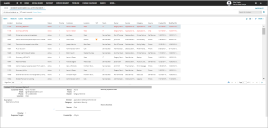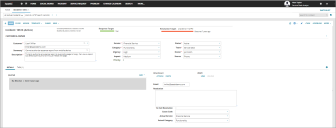Service Manager
Managing Incidents
Managing incidents include the following functionalities:
Viewing an Incident
1.Log in to the Service Desk console.
2.Open the Incident workspace. A list of incidents is displayed.
3.Open an incident to view its details.
Incident Details
The application displays the following information for each incident:
| Field | Description |
|---|---|
|
Customer |
The name of the person who submitted the incident. The application automatically adds the email address, phone number, and location below the customer name. |
|
Summary |
A summary of the incident. Click the search icon |
|
Description |
The description of the incident with relevant details. You must include HTTP:// or HTTPS:// when entering a URL in this field. |
|
Service |
The affected service that is impacted. |
|
Category |
The category. |
|
Urgency |
Specifies the time appropriateness required. The default value is 3. |
|
Impact |
Specifies the impact to the organization, group, or individual. The default value is 3. Impact and urgency together define the priority value: High: Has a major impact on the organization. Medium: Has some effect on the organization but generally not considered a large effect. Low: Does not have much effect on the organization. |
|
Status |
The status of the incident. |
|
Team |
The team to work on the incident. |
|
Owner |
The login ID of the Service Desk Analyst who is assigned to work on this incident. |
|
Source |
Describes how the incident was submitted. |
| Declare as Master Incident |
Specifies if this is a master incident. See Working with Master Incidents. |
| Update Related Incident | (Only shown if you check Declare as Master Incident.) Specifies if the system should update any incidents linked with this master incident with the information in this incident. |
| Resolution | Contains the resolution information. |
| Cause Code |
Contains the root cause of the incident. Choose the desired option from the drop-down list. |
| Actual Service |
The application automatically fills in the value for this field, although you can change it if you need to. |
| Actual Category |
The application automatically fills in the value for this field, although you can change it if you need to. |
| Attachment | Contains attachments. See Working With Attachments and URLs. |
| Asset | Contains links to other business object (such as a configuration item) to this record. See Linking Incidents. |
| Audit Info | Lists the date and time when the incident was created and the date and time when it was last modified. |
| Journal | Contains comments or notes about this incident. See Adding a Journal Entry to a Business Object. |
The system also displays the following tabs:
•Task
•Working With Attachments and URLs
•About Creating a Configuration Item
•About Accessing the Audit History
Creating an Incident
There are several ways to create an incident:
•By using a blank form in the Incident workspace. See Creating an Incident Using a Blank Form.
•By cloning an existing incident in the Incident workspace. See Creating an Incident by Cloning an Existing Incident.
•By using a template in the Incident workspace. When you use a template, the application automatically fills in certain information, depending on the template that you use. You can do either of the following:
•Create an incident and then apply the template to it. See Creating an Incident By Using a Template.
•Apply a template to an existing incident. See Applying a Template to an Existing Incident.
•For an external contact. See Creating an Incident for an External Contact.
Creating an Incident Using a Blank Form
1.Log into the Service Desk console.
2.Open the Incident workspace.
3.From the toolbar, click New Incident. A blank form opens.
4.Enter information into the fields. See Viewing an Incident.
If the customer is not in the database, you must create a new customer.
If you are creating the incident for an end user, set the status to active. When the incident is submitted by the user or through email, the status is logged.
5.Click Save.
•The application notifies the end user that the incident has been logged.
•The application notifies both the Service Desk Analyst and the Service Desk Manager about the incident assignment.
6.Click Refresh to view the resolution target values.
Creating an Incident by Cloning an Existing Incident
1.Log into the Service Desk console.
2.Open the Incident workspace.
3.Open an incident. The incident details open.
4.Select the incident to copy.
5.From the Action Menu, select Form Actions > Clone Incident.
6.Select the incident status from the drop-down list and click OK. A copy of the incident with the new status is created.
•The application does not copy or link any child business objects. For example, the application does not attach any journal email records or tasks associated with the original incident to the new incident.
•The application copies the field values exactly, except for the field values that are overridden by the quick action. You can modify the quick action to specify which fields are automatically copied from the original incident.
7.Update other fields as needed.
8.Click Save.
•The application notifies the end user that the incident has been logged.
•The application notifies both the Service Desk Analyst and the Service Desk Manager about the incident assignment.
Creating an Incident by Using a Template
For a list and description of the incident templates, see Default Incident Templates.
1.Log into the Service Desk console.
2.Open the Incident workspace.
3.In the toolbar, click New Incident > Templates.
4.Select the incident template that matches the incident that you are creating. A incident form opens.
5.Enter as much information as you can.
6.Click Save.
•The application notifies the user that the incident has been logged.
•The application notifies both the Service Desk Analyst and the Service Desk Manager about the incident assignment.
Applying a Template to an Existing Incident
When you apply a template to an existing incident, the system overwrites any existing data.
For a list and description of the incident templates, see Default Incident Templates.
1.Log into the Service Desk console.
2.Open an incident.
3.Do one of the following:
•From the Action Menu, select Templates.
•From the toolbar, click Apply Template.
4.Select a template from the list. The application applies the template to the incident and automatically adds data into the Category, Service, Impact, Urgency, and Summary fields.
5.Enter data in the remaining fields.
6.Click Save.
•The application notifies the end user that the incident has been logged.
•The application notifies both the Service Desk Analyst and the Service Desk Manager about the incident assignment.
Creating an Incident for an External Contact
1.Log into the Service Desk console.
2.Open the External Contact workspace. A list of external contacts opens.
3.Open the external contact record to create an incident for.
4.Click the Incident tab at the bottom of the page.
5.From the toolbar, click New Incident then choose an incident template. The Edit Incident window opens.
6.Enter information into the fields. Each template has various fields auto-filled with data.
7.Click Save. The window closes.
8.Click Save.
Modifying an Incident
You can modify the values in an incident, or update it to correspond to changes in status. The extent to which you can modify an incident depends on your role and edit permissions.
1.Log into the Service Desk console.
2.Open the Incident workspace.
3.Open an incident. The incident details open.
4.Change the information as needed.
5.Click Save.
Was this article useful?
Copyright © 2019, Ivanti. All rights reserved.


 to find matching incidents, problems, and Knowledge Base articles. The application displays a list of related items under
to find matching incidents, problems, and Knowledge Base articles. The application displays a list of related items under 